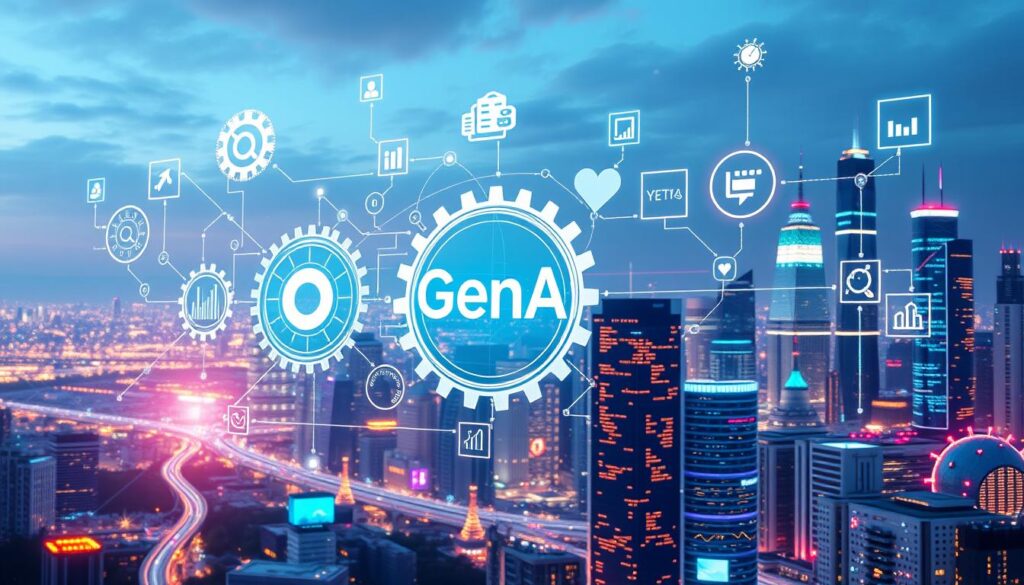n the fast-changing world of digital marketing, GenAi Marketing Automation is making a big difference. It uses AI to make customer experiences more personal. This means businesses can talk to their customers in a way that feels just right.
Automation and GenAi work together to make things easier and smarter. They help businesses send out the right messages at the right time. This leads to happier customers and more sales.
Today’s marketing tools use smart algorithms to make things personal. GenAi helps with tasks like writing emails and creating social media posts. This makes everything more efficient and creative1.
Companies see better results and save money too1. GenAi chatbots, like those from OpenAI and Google Gemini, answer customer questions all day. They give answers that feel natural, making customers happier1.
AI is changing how we do marketing and analysis2. By combining GenAi with old marketing systems, businesses get better at what they do. They can focus on the important stuff while AI handles the rest.
This mix of old and new puts companies ahead in the digital game12. They’re ready for whatever the market throws their way.

Key Takeaways:
- GenAi Marketing Automation is transforming customer interactions by personalising experiences on a large scale.
- AI-powered marketing tools streamline operations and provide insightful data-driven actions.
- GenAI-driven chatbots handle customer inquiries effectively, enhancing customer satisfaction.
- Merging GenAi with marketing automation enhances overall productivity and customer engagement.
- Businesses stand to gain higher conversion rates and reduced operational costs through this integration.
Understanding GenAi Marketing Automation
GenAi Marketing Automation is a big step forward in marketing. It uses artificial intelligence to make marketing campaigns better and more personal. Let’s look at what GenAi marketing automation is and how it helps marketers.
Definition of GenAi Marketing Automation
GenAi marketing automation uses AI to do marketing tasks automatically. It helps manage customer interactions, create custom content, and understand market trends. With generative AI, companies can automate content, respond to customers, and use data to improve marketing.
Benefits of GenAi in Marketing
GenAi in marketing has many advantages. It can save marketers up to three hours a day on content creation, giving them more time for strategy and customer interaction3. Generative AI tools like chatbots also offer 24/7 customer support, improving satisfaction with quick responses worldwide4. AI tools also make marketing more personal, which can boost engagement and sales3.
Key Features of GenAi Tools
GenAi tools have important features to enhance marketing. For example:
- Micro-segmentation: It helps create targeted marketing by dividing audiences accurately4.
- Automated Content Generation: AI can create custom ads and content, like text and videos, for different groups3.
- Real-time Customer Interaction: Chatbots can handle customer feedback and offers in real-time, like discounts or replacements4.
- Enhanced Analysis and Decision-making: AI helps make better decisions with detailed market analysis5.
| Key Features | Benefits |
|---|---|
| Micro-segmentation | Highly targeted marketing strategies |
| Automated Content Generation | Personalised ad variations, diverse formats |
| Real-time Customer Interaction | Instant responses, global reach |
| Enhanced Analysis | Informed decision-making |
GenAi marketing automation is changing marketing for the better. It makes marketing more efficient, accurate, and customer-focused with advanced AI. As we explore this new area, it’s key to keep up with marketing automation trends to use these tools well.
The Role of Tapouts in Omnichannel Marketing
In today’s fast-paced digital world, businesses need to focus on omnichannel marketing to engage customers better. Tapouts, a key term, are when users tap on screens to interact with content. These moments offer valuable insights into what users like and how they behave.
What Are Tapouts?
Tapouts are when users tap or click on screens, playing a big role in digital strategies. They are crucial for businesses to understand user preferences and behaviour. By tracking these interactions, brands can personalise experiences across different channels.
Importance of Tapouts in Customer Engagement
Tapouts are vital for improving customer engagement. They connect different parts of the customer journey, making experiences smooth. For example, in Retail and Banking, GenAI has improved employee training, leading to better customer service6.
Intelligent self-service apps with tapouts can handle simple queries, freeing up human agents for complex issues. This boosts customer satisfaction7. Also, custom content and product suggestions through tapouts can increase engagement and sales8.
The Evolution of Customer Interaction
Customer interactions with brands have changed a lot. They moved from simple clicks to more dynamic taps. This change is thanks to better mobile technology. It shows big changes in marketing.
As more people use mobile devices, it’s key to understand this shift. It affects how brands engage with customers on mobile.
From Clicks to Taps: A Paradigm Shift
At first, we measured interactions by clicks. But now, with smartphones and tablets, taps are the norm. This change shows how consumer preferences have shifted.
It also shows how important mobile engagement strategies are. Marketers can now track and respond to mobile users better. This ensures their strategies stay up-to-date.
This shift has led to an increase in engagement rates, as mobile users find it easier and quicker to interact with content via taps9.
The Impact of Mobile Technology on Engagement
Mobile technology has changed how brands talk to customers. It offers a smooth and easy experience. This has made customers happier and more loyal.
Thanks to marketing changes, brands can now send content that really speaks to people. This makes mobile engagement more effective.
Also, companies are working hard to understand what customers want. They’re making sure all communication channels work together. This helps solve problems faster and builds stronger customer relationships.
The growth of conversational intelligence and automated solutions is a big trend. It’s all about using tech to improve customer interactions10. By knowing why customers call and sharing info ahead of time, brands can avoid problems. This makes for a better customer experience9.
| Generation | Communication Preference |
|---|---|
| Gen X, Y, Z | Automated Solutions |
| Baby Boomers & Millennials | Personal Service |
But, there are challenges with GenAI, like costs and implementation issues11. Still, the move from clicks to taps is a big change. It means brands and customers interact differently now. So, it’s crucial to update mobile engagement strategies to keep up with these changes.
Integrating GenAi with Marketing Automation
GenAi’s integration with marketing automation platforms is a game-changer for marketers globally. It helps in real-time analysis, making automated marketing campaigns more efficient. This combo not only boosts campaign performance but also strengthens customer relationships.
How They Complement Each Other
GenAi and marketing automation work well together. GenAi’s real-time data analysis lets automation platforms respond quickly to customer actions. This partnership makes campaigns more responsive. For example, Michaels Stores saw a 41% rise in SMS click-through rates and a 25% increase in email rates, offering a more tailored experience12.
McKinsey suggests GenAi could add up to $4.4 trillion to global productivity annually. Marketing and sales could grab 75% of that gain12.
Streamlining Customer Journeys with GenAi
GenAi also helps streamline customer journeys when paired with marketing automation. Automated systems, enhanced by GenAi, provide quicker and more personal interactions. A direct-to-consumer retailer saw an 80% drop in first response time and a four-minute cut in average ticket resolution time with GenAi12.
Moreover, GenAi is expected to increase marketing productivity by 5% to 15% of total marketing spend. This could mean around $463 billion annually12.
These improvements make automated marketing campaigns more scalable. Marketers can now craft more dynamic and engaging customer journeys. This boosts customer loyalty and satisfaction.
Creating Effective Omnichannel Strategies
Creating great omnichannel strategies means knowing how to engage customers across all platforms. We use data and automation to make sure customers get the same message everywhere. This way, they have a smooth and consistent experience.
Understanding Multi-Touchpoint Campaigns
Multi-touchpoint engagement is about seeing how customers interact with brands in different ways. A study showed that using three or more channels in a campaign can lead to a 494% higher order rate than using just one13. This shows how important it is to use many touchpoints to improve customer interaction and results.
Best Practices for Omnichannel Marketing
To make effective omnichannel strategies, we focus on a few key areas. These include understanding what customers like, automating tasks, and always improving campaigns:
- Data Use: Using CRM systems and data platforms helps us gather and analyse data from various sources. This includes online buys, social media, and in-store visits14.
- Automation: Automating tasks and centralising campaign management boosts efficiency and flexibility13. Also, using marketing automation and analytics tools gives us insights to improve our strategies14.
- Consistency and Personalisation: Making communications personal based on user behaviour boosts engagement and ensures a consistent experience13. Combining digital and physical channels makes each interaction build on the last, strengthening the brand14.
- Continuous Improvement: Testing different channels through A/B testing helps find the best approaches and campaigns. Regular updates based on data keep strategies relevant and guide customers from awareness to purchase14.
In short, the secret to great omnichannel campaigns is using data, automating tasks, and always improving. These practices help marketers use resources wisely and keep up with market changes.
Measuring Success: Analytics and Insights
GenAi in marketing needs a strong system to measure success. Using GenAi marketing metrics and advanced analytics, companies get deep insights. They learn about customer engagement, conversion rates, and more.
Key Metrics for GenAi Marketing
It’s key to watch several metrics to see if GenAi marketing works. Top businesses aim to boost core service revenue by 27%. They also want to create new revenue sources at 23% and improve existing offerings by 30% with GenAi15.
These metrics help see the return on investment from GenAi. The formula is: ROI = (Financial gains from GenAI – GenAI cost) / GenAI cost * 100%15. Metrics like adoption rate and employee productivity are also important for GenAi’s success15.
Tools for Tracking Customer Engagement
It’s vital to track customer engagement with the right tools. 57% of marketers now see AI insights as key to understanding consumers16. Tools like Google Analytics and CRM software are changing the game17.
Data visualisation platforms like Tableau make complex data easy to understand. This lets marketers adjust strategies quickly17.
SEMRush is great for keyword analytics and website audits. Sprout Social and Adobe Analytics are top for social media metrics17. These tools give insights that improve personalisation and find areas for better customer interaction.
More marketers are using AI tools in analytics, with 62% planning to invest more in AI16. AI and machine learning automate tasks and spot trends humans might miss17. Predictive analytics help define customer segments for customised campaigns17. This shows how crucial GenAi metrics and customer analysis are for business success.
Future Trends in Marketing Automation
The world of marketing automation is changing fast. This is thanks to AI and the need for more personal and efficient marketing. Looking ahead, AI will be key in shaping marketing strategies and tools. GenAI, like OpenAI’s GPT-4, is changing how we create content, saving time and effort for marketers18.
By 2028, AI in marketing is expected to be worth over $107 billion19.
The Rise of AI-Powered Solutions
AI is bringing in new, advanced marketing tools that offer better personalisation. Today, 87% of marketers have tried AI, and 68% use it regularly for tasks like predictive analytics and content creation19. AI helps deliver content and offers that are just right for customers20.
This makes AI crucial for businesses wanting to connect better with their customers. It also makes work faster and saves money18.
Anticipating Changes in Consumer Behaviour
Understanding what customers want is key for businesses. Over half of customers get annoyed with ads for things they’ve already bought19. Marketers need to focus on emotional connections with their audience20.
AI is helping with this by making content more personal, improving customer experience and engagement18. As marketing and sales blend together, being able to predict these changes is vital for success.
Source Links
- https://www.activepieces.com/blog/5-best-generative-ai-automation-techniques-for-2024
- https://www.forbes.com/councils/forbescommunicationscouncil/2024/10/21/navigating-the-future-how-genai-is-transforming-marketing-teams/
- https://nogood.io/2024/04/10/generative-ai-marketing-use-cases/
- https://www.ibm.com/think/topics/generative-ai-marketing
- https://www.linkedin.com/pulse/guide-marketers-who-want-use-generative-ai-avishek-basu-a37lc
- https://isg-one.com/articles/the-cognitive-enterprise–how-to-improve-operations-with-generative-ai
- https://www.speechtechmag.com/Articles/Columns/The-Business-Case/How-AI-Is-Transforming-Self-Service-166184.aspx
- https://aisera.com/solutions/sales/
- https://www.mckinsey.com/capabilities/operations/our-insights/the-evolution-of-customer-care-ai-and-the-gen-z-effect
- https://www.icmi.com/resources/2024/evolution-of-customer-service-agents-in-automated-age-chapter-1
- https://www.icmi.com/resources/2024/4-key-gen-ai-weaknesses
- https://www.mckinsey.com/capabilities/growth-marketing-and-sales/our-insights/how-generative-ai-can-boost-consumer-marketing
- https://www.stackadapt.com/resources/blog/omnichannel-marketing-automation-strategy
- https://www.techtarget.com/searchcustomerexperience/tip/How-to-create-an-omnichannel-marketing-strategy
- https://www.neurond.com/blog/generative-ai-roi
- https://www.kantar.com/north-america/inspiration/ai/genai-fusing-data-and-expertise-to-supercharge-your-insights
- https://marketing.sfgate.com/blog/role-of-data-analytics-in-digital-marketing
- https://www.linkedin.com/pulse/embracing-genai-creative-automation-digital-marketing-sourav-dey-70ajf
- https://thecmo.com/marketing-automation/marketing-software-trends/
- https://cmotech.uk/story/future-of-b2b-marketing-in-2025-ai-globalisation-trends
















